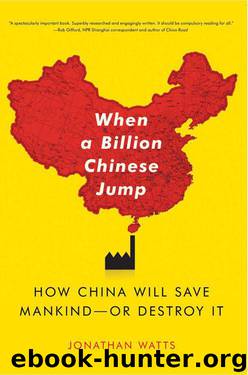When a Billion Chinese Jump: How China Will Save Mankind - or Destroy It. By Jonathan Watts by Jonathan Watts

Author:Jonathan Watts [Watts, Jonathan]
Language: eng
Format: epub
ISBN: 9780571239825
Amazon: 057123982X
Publisher: Faber & Faber
Published: 2010-01-02T05:00:00+00:00
It was not far from heaven to hell in Xinjiang. At the foot of the Tian Mountains was the Turpan Depression, the lowest and hottest place in China. In classical literature, this was a symbol of murderous heat. During the Tang dynasty (618–907), the poet Cen Shen wrote, “No living thing can dwell on this mountain, Even birds dare not fly over.” During the summer months, currents of hot air were said to roll up the barren red sandstone slopes of the nearby Flaming Mountain like tongues of fire. Many travelers passed by on the Silk Road, some recording a climate that always seemed to be summer. The most memorable account was by the Buddhist fabulist Wu Cheng’en of the Ming dynasty (1368–1644). In his novel Journey to the West, Flaming Mountain was so hot that the Buddhist monk Tripitaka and his guardian, the Monkey King, were unable to progress on their quest for enlightenment to Gandhara in India. They learned that the only way to cool the earth was to win over Princess Iron Fan. Today, this episode reads like a global-warming parable or at least a potential advertisement for the wind-turbine manufacturers whose blades are now spinning across much of Xinjiang and northwest China.
Climate change was difficult to pin down. It was too complicated and contradictory to squeeze easily into a given formula. In a small number of cases, glaciers were expanding. The dry plains of Xinjiang were getting more rain than in the past. Some research suggested deserts were absorbing more carbon than previously believed. Assessing the impact was also fraught with imprecision. Global warming was rarely solely responsible for anything. Instead, it intensified existing natural phenomena, such as the summer storms, and accelerated many of the worst trends of human development, such as desertification. In some areas, it even seemed to be beneficial. On the coastal plains, Han farmers enjoyed increased yields as a result of the extra warmth and moisture.
The negative impacts tended to be apparent on the geographic peaks and in the economic depressions. The most dramatic temperature changes were found inland, on high ground during the winter. Melting glaciers in Tibet, Qinghai, Gansu, and Sichuan, dried-up lakes in Hebei and Inner Mongolia, as well as ferocious storms and floods in Guangxi, Guangdong, and Zhejiang. In the mountain forests of Sichuan and Yunnan, sensitive species of orchid, insect, and reptile were dying out as the temperature warmed.29 Off the coasts of Liaoning, striped seal populations were declining along with the icebergs. Among humans, the worst affected were almost always the poorest: nomads who lost their herds when grasslands were engulfed by deserts, farmers on poor land whose crops shriveled up in droughts, and riverside dwellers whose shacks were destroyed in floods. Usually, they were people living closest to nature. Many were Han. But disproportionately, the impact was probably felt most by the ethnic minorities.30 As they lost livelihoods or escaped to cities, tensions rose. Emotions were particularly strong when indigenous people saw their land and natural resources being taken at the same time by an influx of economic migrants.
Download
This site does not store any files on its server. We only index and link to content provided by other sites. Please contact the content providers to delete copyright contents if any and email us, we'll remove relevant links or contents immediately.
| Arms Control | Diplomacy |
| Security | Trades & Tariffs |
| Treaties | African |
| Asian | Australian & Oceanian |
| Canadian | Caribbean & Latin American |
| European | Middle Eastern |
| Russian & Former Soviet Union |
The Secret History by Donna Tartt(18851)
The Social Justice Warrior Handbook by Lisa De Pasquale(12142)
Thirteen Reasons Why by Jay Asher(8797)
This Is How You Lose Her by Junot Diaz(6796)
Weapons of Math Destruction by Cathy O'Neil(6147)
Zero to One by Peter Thiel(5687)
Beartown by Fredrik Backman(5600)
The Myth of the Strong Leader by Archie Brown(5427)
The Fire Next Time by James Baldwin(5250)
How Democracies Die by Steven Levitsky & Daniel Ziblatt(5128)
Promise Me, Dad by Joe Biden(5087)
Stone's Rules by Roger Stone(5026)
A Higher Loyalty: Truth, Lies, and Leadership by James Comey(4846)
100 Deadly Skills by Clint Emerson(4840)
Rise and Kill First by Ronen Bergman(4704)
Secrecy World by Jake Bernstein(4647)
The David Icke Guide to the Global Conspiracy (and how to end it) by David Icke(4627)
The Farm by Tom Rob Smith(4438)
The Doomsday Machine by Daniel Ellsberg(4417)
